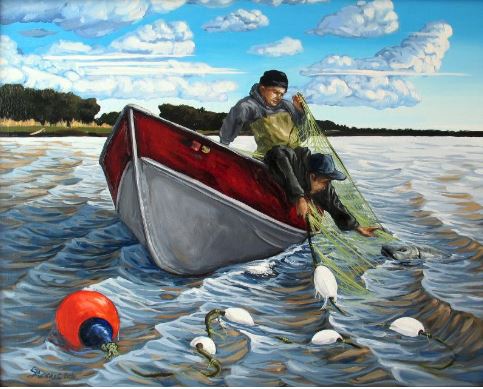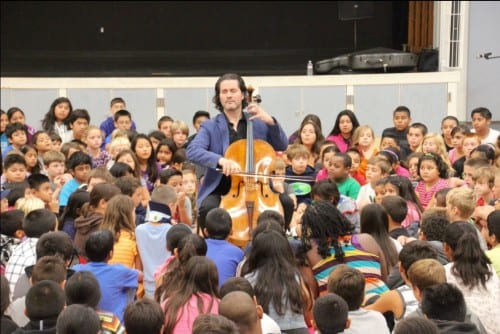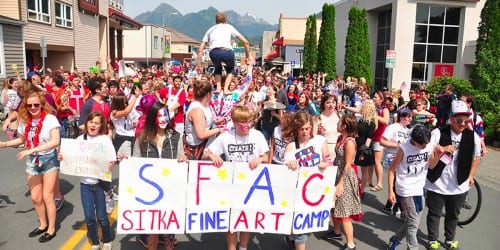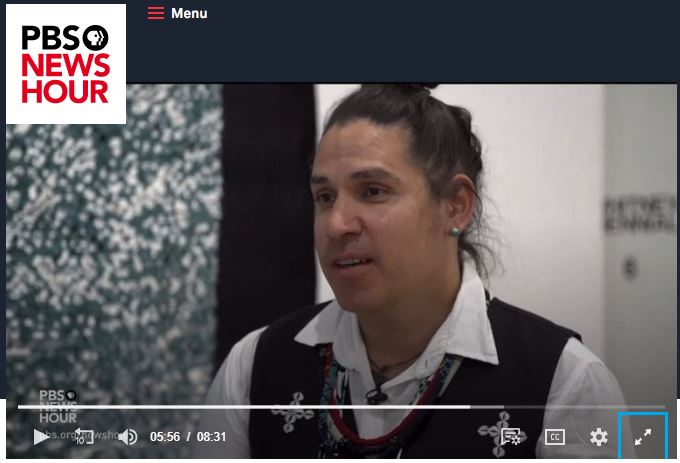
Among the lengthy list of vetoes made to the state budget by Gov. Mike Dunleavy last month was $3.9 million for the Alaska State Council on the Arts. The governor’s veto completely eliminates the program, which is staffed by six people.
CoastAlaska reporters in Juneau and Sitka reached out to artists and organizations to learn more about the economic impact of the Arts Council, its contribution to arts education, and its capacity for cultivating and launching careers.
The veto means an instant loss of $700,000 in federal matching funds
No one is more surprised to see the Alaska State Council on the Arts disappear than its chairman, Benjamin Brown. Gov. Dunleavy re-appointed Brown and added two newcomers (John Kohler of Fairbanks and Juan Muñoz of Juneau) to the Council just last month.
Brown says disbanding the arts council doesn’t make financial sense. That’s because a lot of its work is helping Alaska receive funds from private sector.
“If you look at 10 years ago, almost all of our money was state dollars and federal dollars,” Brown said. “Now, well over half of our budget of just shy of $3 million, is coming from private foundations.”
The Council provides relatively small grants for individual artist projects as well as for institutions. Brown says that community organizations like the Sheldon Museum and Culture Center in Haines and the Fairbanks and Juneau symphonies will all suffer, because those small grants are often leveraged into larger amounts.
The biggest match is from the federal government: the National Endowment for the Arts provides about $700,000 to the state. The governor’s veto means it is gone as well.
“That money has to be matched dollar for dollar,” said Brown. “So first we’re a conduit for federal dollars to come through the state arts agency to be re granted to arts organizations, sometimes individual artists and other worthy programs like arts education programs across the great state of Alaska.”
For many arts and culture organizations in rural Alaska, Council grants the cornerstone of their annual small budgets
Fairbanks Arts Association Executive Director Jess Peña says she’s concerned about the future of arts education.
The Artists in Schools residency program has placed artists in public schools for a half-century. In Fairbanks, for example, there’s a roster of about 20 professional artists who teach in classrooms.
“All of a sudden this really fantastic program that has been augmenting young people’s educational experiences is going to cease to exist,” said Pena.
Also ceasing to exist if the governor’s veto stands: The Governor’s Arts & Humanities Awards, the Silver Hand Seal used to authenticate Native art work, an art therapy program for service members called Creative Forces, and the Poetry Out Loud competition.
A loss of momentum for Alaska’s traveling artists
When grammy-winning cellist Zuill Bailey took over the Sitka Summer Music Festival eight years ago from Paul Rosenthal, he also inherited Rosenthal’s mantle as Alaska’s ambassador of classical music.

With a nearly-indestructible carbon-fiber cello, Bailey performs all across the state.
KTVA Excerpt audio: (Frontiers)
Bailey: It’s very personal but it’s also very broad in how it’s going to impact the entire state. These kinds of cuts could be devastating to the orchestras in the small towns, music education systems, the music in the highland women’s prison. All of the things that basically as human beings give us hope.
Bailey’s travel has been supported by the Harper Arts Touring Fund, which is managed by the Alaska State Council on the Arts. In 2018, $5,000 from the fund sent Bailey, and renowned Australian pianist Piers Lane to Bethel, Kwethluk and Mekoryuk .
When we play in villages we are there for several things: We get to talk about the history of mankind through culture and the arts. We get to perform for them, they get to perform for us. It’s a real exchange.
In addition to a reduced travel budget, the festival will lose $10,000 in direct support from the Council, plus federal matching grants, which offset the cost of free concerts and other community outreach the Festival provides.
Bailey says his fingers are crossed that ….He sees this as a major halt to the state’s progress, and one that, if taken, could be difficult to undo.
“We are really invigorating and changing the lives of one generation at a time, one day at a time,” said Bailey. “We cannot skip a day of inspiration and forward momentum when it comes to mankind.”
A heavy blow to arts education for low-income students
The elimination of the State Council on the Arts shocked Roger Schmidt, executive director of the Sitka Fine Arts Camp.

“It’s devastating for us,” said Schmidt. “The SCA has been funding us for years, it means we’ll have to be cutting our programs back, able to do less for kids that come from rural communities throughout Alaska
The Fine Arts Camp will lose $20,000 annually in Council funding. The organization doesn’t have a plan yet for how it will bounce back from the cuts — Schmidt is hoping the legislature overrides the veto. And he is equally concerned about what the budget cuts means for the local organizations the camp partners with.
“We work with a lot of arts councils throughout Alaska,” said Schmidt. “It varies year to year, we have kids that come from every community in Alaska, a lot of the times we’re not aware of the support they’re getting to be able to make it arts camp but it’s often the work of the SCA.”
Some level of state arts funding makes it possible for kids from low-income and rural communities to attend the camp every year. Schmidt cannot understand why Gov. Dunleavy would reduce funding for such programs.
“He surprises me in his ignorance about what matters to Alaska and how to build a strong state,” said Schmidt. “I think he’s going to be the single most damaging thing to our economy and quality of life that I’ve seen in my lifetime.”
Cultivating artists, and launching their careers
This is one of Alaska’s top artists, featured in a recent segment of PBS NewsHour.

…This is a reference to that noise in conversation towards our cultural communities, which is our histories, our stories, our voices…
Nick Galanin is describing a textile piece of his called “White Noise,” which is installed in New York City’s Whitney Museum of American Art, as part of its 2019 Biennial Exhibition. Galanin is one of only 75 American artists selected for the show — and it’s not a huge surprise: Galanin’s work is appearing in venues all over the world.
“Lots of shows up right now,” Galanin reports, “solo shows opening up internationally.”
I caught up with Galanin by cell phone while he was on a layover between flights. He says that he’s had a lot of support from the Alaska State Council on the Arts — money to purchase tools, funds for travel, and master and apprentice grants for large projects like a 40-foot totem pole he carved and raised in Juneau last year.
KCAW – Going back about how far is your relationship with the Arts Council?Galanin – From when I first started practicing, almost twenty years ago.
So there’s also an element of faith in the work of the Council, that an Alaskan like Nick Galanin will one day be shown in the Whitney.
Filmmaker Ellen Frankenstein agrees that the Council is about much more than the money.
“They’ve also been allies in thinking about what art means to enriching a state, and to give people access to creativity, and thinking what’s going on,” she said.
Frankenstein has done around eight Artist-in-Schools residencies around the state sponsored by the Council, and had several Community Development Grants, including one to produce a series of films on social media about life on Sitka’s tiny road system, called “14 Miles.”
Frankenstein believes nothing brings people together quite like the arts.
“I’ve worked with so many young people — so many people — in this community and I think how people think — which is what art can do, and help you see what’s around you — is really important,” said Frankenstein.
If the governor’s veto goes through, Alaska will be the only state without a Council on the Arts.






























